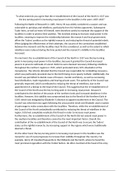‘To what extent do you agree that the re-establishment of the Council of the North in 1537 was
the key turning point in increasing royal power in the localities in the years 1485-1603?’
Following the Battle of Bosworth in 1485, Henry VII was widely considered a usurper and was
vulnerable to uprisings and rebellions, particularly from his Yorkists opponents. Subsequent
Tudor heirs, as well as Henry VII himself, were therefore careful to maintain the support of the
localities in order to protect their position. This involved aiming to increase royal power in the
localities, meaning to improve the relationship between the monarch and local government;
affirm the Tudors’ position as the rightful monarch; and reducing the threat of potential rebels.
When judging the effectiveness of their attempts, the success of the connections established
between the monarch and the localities must first be considered, as well as the extent to which
rebellions were reduced during the time period and the monarch’s visibility in the localities
increased.
On one hand, the re-establishment of the Council of the North in 1537 was the key turning
point in increasing royal power in the localities, because it granted the Council increased
powers to prevent outbreaks of unrest. Reforms were deemed necessary following rebellions
throughout the northern regions in 1535, which protested Henry VIII’s dissolution of the
monasteries. The reforms dictated that the Council was responsible for combatting recusancy,
which was particularly prevalent due to the North being more openly Catholic. Additionally, the
Council was permitted to decide cases of treason, murder and felony, as well as overseeing
food distribution, trade regulations and hearing private cases. The authority of the Council was
generally respected, which contributed to reducing the threat of rebellions, due to the
appointment of a bishop to the head of the Council. This suggests that the re-establishment of
the Council of the North was the key turning point in increasing royal power, because it
contributed to the decline of the power of the northern lords and increased obedience in the
localities. However, this stability was compromised due to the Revolt of the Northern Earls in
1569, which was instigated by Elizabeth I’s decision to appoint southerners in the Council. The
Council was reformed once again following the unsuccessful revolt and Elizabeth used a system
of patronage to make connections with the localities. Therefore, while the re-establishment of
the Council of the North undoubtedly contributed to reducing the threat of rebellions in the
region, it did not completely eradicate this threat in order to increase royal power.
Furthermore, the re-establishment of the Council of the North did not extend royal power in
the southern localities and therefore cannot be the most important factor. Overall, the
contribution of the re-establishment of the Council of the North was to secure the Tudors’
status as the rightful monarchs, by increasing support in the regions which were traditionally
deemed a threat.
On the other hand, the key turning point in increasing royal power in the localities was the
monarchs’ use of royal progresses to increase their visibility throughout the country. For
example, Henry VII travelled frequently to the Midlands and the North, where he faced the
most prominent opposition with the Yorkist faction. He often marched at the head of his army





